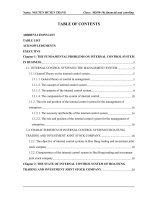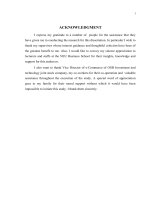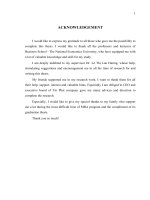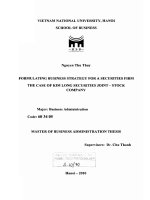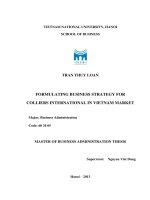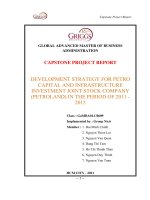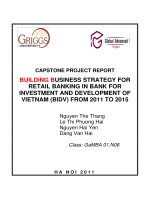Business strategy for vegetable oil in cambodian market of Vietnam national sundries import and export joint stock company until 2018
Bạn đang xem bản rút gọn của tài liệu. Xem và tải ngay bản đầy đủ của tài liệu tại đây (2.49 MB, 106 trang )
GaMBA01.C0411- Group 02– Strategic Management
Page i
GLOBAL ADVANCED MASTER OF BUSINESS
ADMINISTRATION
BUSINESS STRATEGY FOR VEGETABLE OIL IN
CAMBODIAN MARKET OF VIETNAM
NATIONAL SUNDRIES IMPORT AND EXPORT
JOINT STOCK COMPANY UNTIL 2018
Class : GaMBA01.C0411
Group: 2
1. Truong Hong Hai
2. Do Trung Truc
3. Nguyen Mai Anh Kha
4. Nguyen Minh Duc
TP.HCM - 2013
GaMBA01.C0411- Group 02– Strategic Management
Page ii
ACKNOWLEDGEMENTS
First of all, we would like to express our appreciation to all professors and staff
at ETC - Nation University Hanoi for giving us chance to obtain knowledge in
mordern advanced business administration. We highly appreciated their support to
help us successfully accomplish the whole program of Global Advanced Master of
Business held by the Center.
We also would like to thank our classmates from GaMBA.C0411 class who
always supported and encouraged us while completing this paper.
Last but not least, we would like to give thanks tothe Board of Management of
TOCONTAP for its provision of relevant data of the Company.
The joint paper could not have been completed without the cooperation and hard
work of all members of the Group resulting in deep understanding and high accord
when choosing the topic, gathering information and analyzing them.
GaMBA01.C0411- Group 02– Strategic Management
Page iii
ABBREVIATIONS
TOCONTAP: Vietnam national sundries import and export joint stock company
BCG : Boston Consult Group matrix
EFE : External Factor Evaluation Matrix
IFE :Internal Factor Evaluation Matrix
CPM :Competitive Profile Matrix
QSPM: Quantitative strategic planning matrix
SWOT: Strengths- weaknesses- opportunities- threats
SPACE: Strategic Position &ACtion Evaluation matrix
GDP : Gross Domestic Products
GaMBA01.C0411- Group 02– Strategic Management
Page iv
Contents
ACKNOWLEDGEMENTS ii
INTRODUCTION 1
1. General 1
2. Objectives and scope: 1
2.1. Objectives: 1
2.2. Scope: 2
3. Method: 2
4. Outline: 2
CHAPTER 1: RATIONALE OF STRATEGIC MANAGEMENT 3
1.1. Concept of business strategy planning 3
1.1.1. Concept of strategic management 3
1.1.2. Role of business management towards enterprises 4
1.2. Classification of business strategy 4
1.2.1. Specific strategies 4
1.2.2. Perspective of Michael Porter about the typical strategies 6
1.3. Process of strategic planning 7
1.4. External factor evaluation 8
1.4.1. Macro factor evaluation 8
1.4.2. Industry factor evaluation 10
1.5. Internal factor evaluation 11
1.6. SWOT 11
1.7. Matrixes for effective selection of strategies 12
1.7.1. Process to form a general strategy 12
GaMBA01.C0411- Group 02– Strategic Management
Page v
1.7.2. Industry evaluation: External Factor Evaluation (EFE) 12
1.7.3. Industry evaluation: Competitive Profile Matrix (CPM) 14
1.7.4. Analysis of operation: Internal Factor Evaluation (IFE) 15
1.7.5. Strengths- weaknesses- opportunities- threats (SWOT) 15
1.7.6. Internal-external factor matrix (IE) 17
1.7.7. BCG matrix 17
This matrix is offered by the leading management consultancy company of the U.S as Boston
aiming to help the large companies assess the operating situaiton of the business units. From
that, the managers will decide to allocate the capital for SBU and assess the finacial situation
of the company. 17
1.7.8. SPACE matrix 18
1.7.9. Quantitative strategic planning matrix QSPM 19
CHAPTER 2: CURRENT PRODUCTION AND BUSINESS IN VEGETABLE OIL
OF TOCONTAP 21
2.1. Introduction to TOCONTAP 21
2.1.1. Overview 21
2.1.2. Establishment and development 21
2.1.3. Organizational structure of company 26
2.1.4. Business Model of Vegetable Oil 26
2.1.5. Process of vegetable oil 27
2.2. Internal factor evaluation of TOCONTAP. 28
2.2.1. Human resources 28
2.2.2. Management activity 29
2.2.3. Marketing activities 30
2.2.4. Financial management activity 31
2.2.5. Information System 33
2.2.6. Operating results 34
GaMBA01.C0411- Group 02– Strategic Management
Page vi
2.2.7. Corporate Culture 34
2.2.8. Internal Factor Evaluation Matrix (IFE) 35
2.3. Analysis of external factors 36
2.3.1. Analysis of macro environment 36
2.3.2. Analysis of the micro-environment 41
2.4. General observation 53
2.4.1. STRENGTHS OF TOCONTAP 53
2.4.2. WEAKNESSES OF TOCONTAP 55
2.4.3. CHANCES OF TOCONTAP 55
2.4.4. RISKS OF TOCONTAP 56
CHAPTER 3: TOCONTAP’S BUSINESS STRATEGY FOR VEGETABLE OIL
ON CAMBODIAN MARKET IN 2018 57
3.1. Development target of TOCONTAP 57
3.1.1. Vision, mission, core values, and business philosophy 57
3.1.2. TOCONTAP’s target for vegetable oil up to 2018 57
3.2. TOCONTAP’s business strategy for oil in 2013 -2018 58
3.2.1. SWOT Matrix 58
3.2.2. Selection of strategies based on QSPM: 61
3.2.3. Deciding Strategies: 71
3.3. Solutions to implement strategic product development in the vegetable oil in Cambodian
market in the period from 2013 to 2018: 73
3.3.1. Solutions to enhance marketing activities: 73
3.3.2. Solution to develop market share: 77
3.3.3. Solutions to increase investment 78
3.3.4. Solutions to training and development of human resources: 78
3.3.5. Solutions to Financial Management 80
GaMBA01.C0411- Group 02– Strategic Management
Page vii
3.4. Recommendations 82
3.4.1. For the Government 82
3.4.2. For institutes and universities 83
3.4.3. For producers and oil business 83
CONCLUSION 84
APPENDIX 1 85
APPENDIX 2 94
APPENDIX 3 96
REFERENCES 99
GaMBA01.C0411- Group 02– Strategic Management
Page 1
INTRODUCTION
1. General
In the present trend of economic integration, the competition is very fierce. If
the companies want to survive on the market sustainably, and want their products
can compete with the products of other enterprises, there is no way other than an
effective business performance. Therefore, it is a concern for any enterprises to find
solutions for effective business performance.
Before the increasing entries of vegetable oil enterprises in domestic country,
the competition is severer and severer. TOCONTAPchooses the direction as the
exporter of goods including the export of vegetable vegetableoilto Cambodian, Laos
and Myanmar markets. Through the market survey and trade in previous items in
Cambodia, we conducted a theroretical research on competitve strategy, analyzed
the business situation of TOCONTAPto develop a business strategy for
Wellcookvegetable oil at the Cambodian market until 2018.
2. Objectives and scope:
2.1. Objectives:
The business enviroment of vegetable vegetableoilis changing quickly and the
competition is very fierce among enterprises at Cambodian market. The
choose of this topic aims to:
Analyze the main and decisive factors of business performance of TOCONTAP
in the present and future. Specifically, perform the internal and external factor
evaluation to identify the opportunities and threats aiming to determine the
competitive advantage of the company in the vegetable oil industry in
Cambodian market.
Propose the feasible business strategy for TOCONTAP Company towards the
vegetable oil products.
GaMBA01.C0411- Group 02– Strategic Management
Page 2
Suggest the solutions in order to support for the implementation of successful
solutions.
2.2. Scope:
The dissertation mentions to the most basic concepts as the strategic
management planning; analysis of matrixes aiming to select the efefctivestartegies;
internal and external factor evaluation of enterprises, concepts of vegetable oil
production, etc. and related concepts.
From the above theoretical concepts, we will apply it to develop the business
strategy for TOCONTAPvegetable oilbrandedWellcook at Cambodian market until
2018.
3. Method:
The Qualitative Research Method through the discussion with the managers
and experts of the vegetable oil company to analyze the tendency of market. In
addition, the dissertation also uses the appropriate secondary documents to analyze
the issues related to the topic.
4. Outline:
With the content mentioned as follows, the dissertation has the structure as
follows:
Chapter 1:Literature review
Chapter 2: Current production and business in vegetable oil of TOCONTAP
Chapter 3: Business strategy for vegetable oil products in Cambodia market
until 2018
GaMBA01.C0411- Group 02– Strategic Management
Page 3
CHAPTER 1: RATIONALE OF STRATEGIC MANAGEMENT
1.1. Concept of business strategy planning
1.1.1. Concept of strategic management
The concept of “strategy” appeared early in the studies for the purpose of
war in the history. According to the ordinary definition (the Greek word is
strategic). It is a military term indicating the planning and arrangement of force with
the purpose of defeating the enemies. Sun Tzu is aChinese military. He wrote the
book “the Art of Operation” discussing on the military strategy.
Carl von Clausewitz – the author of “the art of operation” in the century 19 –
considered the strategy as the “planning of operation and implementation of
schedule”.
Until the middle of century 20, the research and development of business
strategy was really strong. From the scholars Drucker, Chandler, Ansoff, Andrew,
those research the development of great success of economic groups in the United
State before and after the Second World War, to the present economic managers
such as Michael E.Porter, Fred R.David, Rudolf Grunig, Richard Kuhn…had
different views of business strategic managements.
According to Wikipedia, the strategic management is a science and art
aiming to develop the orientation and objectives, implement the short and long-term
plan based on the available resources, help each organization obtain its long-term
objectives.
These are different definitions of strategies:
“The strategy is the determination of basic and long-term objectives and
purpose of company and use of actions as well as distribution of necessary
resources to reach such objectives” – Chandler (1962).
“The strategy is to combine the resources between the organization and
environment, the systematical consistence between the decision of organization and
environment” – Mintzberg (1979).
GaMBA01.C0411- Group 02– Strategic Management
Page 4
“The strategy is a system or plan aiming to integrate objectives and policies
and series of actions to a close general” – Quinn (1980).
“The strategy is a difference. Those are the selections of calculation for
different actions to create the best value” – Michael E.Porter (1996).
“The strategy is the means to obtain the long-term objectives” – Fred R.
David (2003).
“The strategy is the orientation to long-term management and ensure the
accomplishment of long-term objectives and main purpose of company” – Rudolf
Grunig and Richard Kuhn (2003).
1.1.2. Role of business management towards enterprises
The strategic management and development promote the enterprises in term of
following issues:
- Obtain the long-term and stable objectives of company.
- Gain the market or market share.
- Resources (human resources, ability, asset, finance, technical method) to obtain
the above objectives.
- External potential threats affecting to the implementation of strategies include
the environment, politic, natural resources, etc. and solution for prevention.
- The value that the enterprise brings for the owner and society.
1.2. Classification of business strategy
1.2.1. Specific strategies
According toR.David, it can be divided into 14 typical types and it is
classified into 4 groups as follows:
1.2.1.1. Integration strategy
- Forward integration: it relates to the increase in ownership or control for the
dealers or retailers. The effective solution to promote this integration strategy is
the transfer of ownership. The companies can develop quickly through the
GaMBA01.C0411- Group 02– Strategic Management
Page 5
transfer of ownership because the cost and opportunities are divided for
members.
- Backward integration: it relates to the search for ownership or control of
suppliers. This strategy is especially suitable when the present suppliers are not
reliable at high price and fails to meet the demand of company.
- Horizontal integration: it relates to the construction of ownership or control for
the competitors. The merger and acquisition help to improve the efficiency of
scale and increase in exchange of resources and ability.
1.2.1.2. Intensive strategies
- The market penetration is to research the additional market share for the
products and services in the existing markets through the efforts of marketing.
The market penetration includes the increase in marketing staff, increase in
advertising cost, products or other advertising efforts.
- Market development indicates the offer of existing products and services to new
fields
- Market development is the increase in revenue by improving or adjusting the
current products or services. The product development requests the high cost for
development and research.
1.2.1.3. Vertical strategies
- The diversification of center activities is to supplement new products or
services, but it must supplement to each other.
- The diversification of activities under the horizontal regime is to supplement
new products and services, but not related to the existing customers.
- The diversification of activities in the integrated regime is to supplement new
products and services, but it does not interact each other
1.2.1.4. Other strategies
- Share: two or more companies are mixed into an independent company for the
purpose of cooperation.
GaMBA01.C0411- Group 02– Strategic Management
Page 6
- Narrowed activity is the enhancement by reducing the cost and asset aiming to
save the revenue and profit.
- Cutting down on the activities is the sale of a branch or a part of Company.
- Liquidation is the sale of all assets at the fixed value.
- Combination is the collection of two or more strategiesat the same time.
1.2.2. Perspective of Michael Porter about the typical strategies
According to Porter, basic strategieshelp the company to obtain the competitive
advantage in term of 3 different aspects:
- The cost strategy produces the standard asset at the low rate aiming to meet the
customers who are sensitive with the price.
- The segment is the strategy indicating the production of product as the typical
for the customers who did not care about the price.
- The concentration is the production of products and services in order to meet
the demand for small customer segments.
One reason to apply the forward strategy, backward strategy or horizontal
strategy is to obtain the benefits in the price orientation.
Product development is a basic strategy with many advantages to create the
characteristics for products (segment strategy). The typical of successful products is
that it has a high flexibility, strong ability of combination, low price, improvement
of service, less warranty, high convenience, or has a lot of characteristics.
The market penetration and market development brings many advantages.
GaMBA01.C0411- Group 02– Strategic Management
Page 7
1.3. Process of strategic planning
Table 3.1: DIAGRAM OF COMPREHENSIVE STRATEGY
MANAGEMENT
(Source: Fred. David – Overview of strategic management)
The process of strategic management includes 3 stages
- Set the strategies.
- Implement the strategies.
- Evaluate the strategies.
Fred R.David gave the comprehensive strategic management model as table
3.1. Particularly, the stage of setting the plan includes steps: determine the vision,
mission, and objectives and then evaluate the external factors to determine the
threats and opportunities to clarify the strengths and weaknesses of the company.
Allocate
resources
Re-determine the
business
objectives
Evaluate internal
factors, determine
the strengths and
weaknesses
Choose the
strategies
Propose the
polciies
Make the plan for classification plan
Vision,
mission,
objectives
Evaluate the
external factors,
determine the
opportunities and
threats
Evaluate
the
implementa
iton of
strategy
Set long-
term
objectives
Set annual
objectives
GaMBA01.C0411- Group 02– Strategic Management
Page 8
From that, determine the business objectives and set the long-term objectives as
well as chose the strategies. The stage of implementing the strategies will include
the allocation of resources aiming to obtain the annual objectives and policy. The
final stage is the calculation and assessment of implementation.
1.4. External factor evaluation
1.4.1. Macro factor evaluation
The external condition is all external factors that the Directors fail to control,
and it causes a great impact on the development and profitability of each company.
External factor evaluation relates to the micro and macro factor evaluation.Analysis
of these factors will help the company determine its position and characteristics of
environment, and obtain the impact of environment on the enterprises aiming to
make the appropriate decision in strategic planning.
The change in macro-environment can directly affect all resources in
industry, resulting in the change of interaction between the resources and
attractiveness of industry. The macro-environment includes 6 parts: economic,
demographic, sociocultural, Demographic, political/legal, technological and global.
Table 3.1. FACTORS OF MACRO-ENVIRONMENT
GaMBA01.C0411- Group 02– Strategic Management
Page 9
Economic
The economic factors are the growth rate, the stability of economy, purchasing
power, the price stabilization, money, inflation, exchange rate, etc. affecting to the
business performance.
Cultural-social
Cultural and social factors affect to the profit of company in the market
research. The social factors will divide the community into different customer
segments with the different characteristics, psychology and income.
- The average age, situation of health and nutrition
- The average income, allocation of income
- Life-style, understanding, perspective of aesthetic, and psychology
- Living condition.
Demographic:
Demographic factors indicate the structure of population, structure of age,
distribution, minority and allocation of income.
Political/ legal:
- Political stability
- Tax policy.
- Law and trade policy
Technical
Technical factors are new production method, new material, equipment. Way
of production, invention and applied software …
Global
The process of integration and globalization requests the enterprise to consider
the international factors during the process of planning to offer the long-term
strategies with the opportunities of integration and expansion in term of geography
and politic.
GaMBA01.C0411- Group 02– Strategic Management
Page 10
1.4.2. Industry factor evaluation
According to Michael Porter, there are five competitive factors in the
industry including:: (1)new entrants; (2) Ccompetition between the existing
companies; (3) Bargaining power of purchaser; (4)Bargaining power of seller; (5)
Threats of substitute products or services.
Table 3.1 MODEL OF FIVE COMPETITIVE FACTORS
The competitive pressure from the suppliers
- Quantity and size of suppliers
- The substitutes of products of suppliers
- Information on supplier.
Competitive pressure from customer
The customer is divided into 2 segments including the retail customer and
dealer. These customer segments can put the pressure on the enterprises in term of
product price, quality as well as attached services. They can control the competition
in industry by making decision on buying the commodities and services.
Competitive pressure from potential entrants
According to Michael Porter, the potential entrants for enterprises do not
appear in the market, but it will cause the effect in the future.
Competitive pressure from substitute products
GaMBA01.C0411- Group 02– Strategic Management
Page 11
Substitute products and services are the products that can satisfy the needs of
customer.
Competitive pressure from industry
The enterprises in the same industry will compete with each other to put the
pressure in the industry and create the fierce competition. The industry factors can
increase the pressure for the competitors:
- The status of industry
- The industry structure
1.5. Internal factor evaluation
For survival and development, all organizations must implement the
activities including the management, finance, accounting, production, business,
research and development, marketing, etc. and a system of information
management. In each operating industry, each organization has its own strengths
and weaknesses.
Internal factor evaluation is one of the important and essential parts of the
strategic management. If we do not perform tis analysis well, we will not identify
the strengths and weaknesses, and we cannot have a perfect strategy.
1.6. SWOT
SWOT is the analysis of external factors that the enterprises must encounter
(opportunities and threats) as well as internal factors (strengths and weaknesses).
The enterprises determine the opportunities and threats through the analysis of data
about the change in environment including the economic, financial, political/ legal,
social and competition in the markets that the companies are operating or intend to
participate.
For the internal factor evaluation, the strength of company may be the skills,
resources and advantages against the competitors (key capacity of company). The
GaMBA01.C0411- Group 02– Strategic Management
Page 12
weaknesses of companies are the restriction or weaknesses as well as weak skill and
resources and factors reducing the competition of companies.
1.7. Matrixes for effective selection of strategies
1.7.1. Process to form a general strategy
According to Fred R. David, the process for strategy will include 3 steps
including penetration, integration and decision
Stage 1: Penetration
External factor
evaluation (EFE)
Profile competitive system
Internal Factor Evaluation (IFE)
Stage 2: Integration
Strengths-
weaknesses-
opportunities-
threats (SWOT)
Assess the
strategies and
action
(SPACE)
Advisor group
(BCG)
Internal/external
system (IE)
General
strategy
system
Stage 3: Decision
Quantitative strategic planning matrix (QSPM)
1.7.2. Industry evaluation: External Factor Evaluation (EFE)
- EFE assess the external factors, tổng hợp and summarize the opportunities and
threats of external factors of the operating process of the company. From that, it
helps the managers to assess the level of response of the company to the
opportunities, threats and offer the assumptions of external factors as the
advantages or disadvantages of the company
- Step 1: list 10-20 key opportunities and threats that you suppose that they can
affect the success of the company in the industry/ field
GaMBA01.C0411- Group 02– Strategic Management
Page 13
- Step 2: Assess the level of importance of each factor according to the range
from 0,0 (not important) to 1,0 (very important) for each factor. The importance
of each factor depends on the level of influence of such factor on line of
business that the company is doing the business. Total score of each factor must
be 1.
- Step 3: Determine the weight from 1 to 4 for each factor. The weight of each
factor depends on level of response of each company to factor. 4 is good
response. 3 is over average response. 2 is average response and 1 is less
response
- Step 4: Multipy the importance of each factor with its weight to get the score of
importance.
- Step 5: Sum up score of all factors to determine total score of matrix.
Assessment
Total score of matrix does not depend on the quantity of factors in the
matrix, the highest score is 4, and the lowest score is 1.
Factors
Level
of
importa
nce
DL 1
DL 2
DL 3
Classif
ication
Important
score
Classifi
cation
Important
score
Classif
ication
Important score
1
2
3
4=2x3
5
6=2x5
7
8=2x7
Market share
Competition
External
financial
support
GaMBA01.C0411- Group 02– Strategic Management
Page 14
If total score is 4, the company has a good response to the opportunities and
threats
If total score is 2.5, the company has an average response to the opportunities
and threats.
If total score is 1, the company has weak response to the opportunities and
threats
1.7.3. Industry evaluation: Competitive Profile Matrix (CPM)
All factors of enterprises, the impact of competition is often considered as the most
important. The Competitive Profile Matrix is the expansion of external factor evaluation
where the level of importance, classification and total important score have the same
meaning.
Total assessed score of competitors is compared to the sample enterprises. These factors
will be listed in this matrix including the market share, competition, financial position,
product quality, loyalty of customer.
The classification shows the way that the strategies of enterprise will response to each
factor of competitor: 4 is the best level of important; 3 is higher than the average, 2 is the
average and 1 is weak.
Quality of
travel products
Cost/ product
Loyalty of
customer
Response to
the change
TOTAL
GaMBA01.C0411- Group 02– Strategic Management
Page 15
1.7.4. Analysis of operation: Internal Factor Evaluation (IFE)
Internal factors are considered as very important for each business strategy and objectives
proposed by company. After considering the internal factors, the strategic managers need
to set the matrix for these factors aiming to consider the ability to response and recognize
the strengths and weaknesses. From that, it helps the company to take advantage of
strengths to exploit and prepare the internal force to fight with the weaknesses and find out
the ways of improvements for these weaknesses.
To establish the IEF, we need to implement 5 following steps:
Step 1: list 10-20 key opportunities and threats that you suppose that they can affect
the enterpsies and the goals proposed by the enterprises
Step 2: Assess the level of importance of each factor according to the range from
0,0 (not important) to 1,0 (very important) for each factor. The importance of each
factor depends on the level of influence of such factor on the sucess of the
enterprises in the same industry. Total score of each factor must be 1.
Step 3: Determine the weight from 1 to 4 for each factor. 4 is good response. 3 is
over average response. 2 is average response and 1 is less response
Step 4: Multipy the importance of each factor with its weight to get the score of
importance.
Step 5: Sum up score of all factors to determine total score of matrix.
Assessment:
Total score of matrix that is not in the range from 1 to 4, will not depend on the number of
important factors in the matrix.
If total score is below 2.5, the company has a weak internal factors
If total score is above 2.5 point, the company has a strong internal factors
1.7.5. Strengths- weaknesses- opportunities- threats (SWOT)
The strategies are based on the analysis and assessment of factor, identification of
strengths, weaknesses, opportunities and threats affecting the survival of the enterprises.
From that, determine the strategic solutions to obtain the proposed objectives.
GaMBA01.C0411- Group 02– Strategic Management
Page 16
Ma trận SWOT
SWOT Matrix
WT
Strategies
Gi
ả
m thi
ể
u đi
ể
m y
ế
u và né
tránh các đe d
ọ
a
Minimize wea knesses and avoid
threats
ST
Strategies
Dùng đi
ể
m m
ạ
nh đ
ể
kh
ắ
c
ph
ụ
c/ né tránh các đe
d
ọ
a
Use strengths to avoid
threats
Threats –
T
List Threats
(li
ệ
t kê các Đe d
ọ
a)
WO
Strategies
Kh
ắ
c ph
ụ
c đi
ể
m y
ế
u đ
ể
t
ậ
n d
ụ
ng
c
ơ
h
ộ
i
Overcoming weaknesses by
taking advantage of
opportunities
SO
Strategies
Dùng đi
ể
m m
ạ
nh đ
ể
t
ậ
n
d
ụ
ng các c
ơ
h
ộ
i
Use strengths to take
advantage of
opportunities
Opportunities –
O
List Opportunities
(li
ệ
t kê các C
ơ
h
ộ
i)
Weaknesses –
W
List Weaknesses
(li
ệ
t kê các Đ
Strengths –
S
List Strengths
(li
ệ
t kê các Đi
ể
m
m
ạ
nh)
Leave Blank
Luôn đ
ể
tr
ố
ng ô
này
Figure 1.5: SWOT model
Strengths and Opportunities strategy (SO): Use the internal strengths to take advantage
of external opportunities. When a company has large weaknesses, it will try to overcome
and make it become the strength. When an organization must confront to the threats, it will
find ways to avoid them, so that it can focus on the opportunities.
Strengths- weaknesses strategy (WO):Improve the internal weaknesses by taking use of
external opportunities. Sometimes, the external opportunities exist; the company has the
internal weaknesses to prevent them from exploiting these opportunities.
Strengths and threats strategy (ST): Use the strengths of a company to get away from or
cut down on the impact of external threats.
Weaknesses- threats strategy (WT): it is the defense strategy aiming to reduce the
internal weaknesses and avoid the external threats
To establish the SWOT, we must do 8 steps:
Step 1: List external opportunities of company;
Step 2: List external threats of company;
Step 3: List of internal strengths of company;
Step 4: List of internal weaknesses of company;
GaMBA01.C0411- Group 02– Strategic Management
Page 17
Step 5: Combine the internal strengths and external opportunities and record the
result of SO strategy to the appropriate cell;
Step 6: Combine the internal weaknesses with the external opportunities and record
the result of WO strategy;
Step 7: Combine the internal strengths with the external threats and record the result
of ST strategy.
Step 8: Combine the internal weaknesses with the external threats and record the
result of WT strategy.
1.7.6. Internal-external factor matrix (IE)
This matrix depends on two main aspects including total importanr score of IFE in
X azis and total importanr score of EFE in Y axis.
IE matrix can be divided into 3 main fields: each field includes different
strategies.
1.7.7. BCG matrix
This matrix is offered by the leading management consultancy company of
the U.S as Boston aiming to help the large companies assess the operating situaiton
of the business units. From that, the managers will decide to allocate the capital for
SBU and assess the finacial situation of the company.
The BCG matrix is a table consisting of 4 cells including:
Horizontal axis: Show the relatove market share of SBU determined by the
percentage between the sales of SBU and the sales of the leading competitors or
second competitors.Where SBU is not the leading sales of relative market share of
SBU, it isequal to the percentage between the sales of SBU and the sales of the
competitor.Where SBU is the leading sales of relative market share of SBU, it is
equal to the percentage between the sales of SBU and the sales of the second
competitor.
Vertical axis: indicate the annual growth of the market for the products that
GaMBA01.C0411- Group 02– Strategic Management
Page 18
ABU business in percentage. If the percentage of SBU is higher than 10%, MGR is
high (MGR: Market Growth Rate).
1.7.8. SPACE matrix
The SPACE matrix is a management tool used to analyze a company. It is
used to determine what type of a strategy a company should undertake. The
core of content are following:
Conservative
Aggressive
Defensive
Competitive
THỊ PHẦN TƯƠNG ĐỐI
(RELATIVE MARKET SHARE)
BÒ SỮA
CASH-COWS
CON CHÓ
DOGS
NHỮNG NGÔI SAO
STARS
DẤU HỎI
QUESTION MARKS
20%
10%
0%
0,1x
1X
10X
1
2
3
4
5
6
7
CAO
THẤP
HẸP
RỘNG



